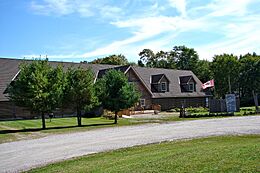Sturgeon River House Museum facts for kids
 |
|
| Established | 1967 |
|---|---|
| Location | Sturgeon Falls, Ontario |
| Type | Community museum |
| Collection size | abt. 1 000 |
| Visitors | abt. 10 000 |
| Owner | Municipality of West Nipissing |
The Sturgeon River House Museum (also called SRH) is a fun place to learn about Canadian history and nature. It's located in Sturgeon Falls, Ontario, Canada. This museum helps keep the stories and natural beauty of the West Nipissing area alive.
The museum teaches visitors about the exciting fur trade from 1623 to 1879. It also shows what life was like for pioneers in West Nipissing between 1878 and 1939. You can learn about the important contributions of the three main groups who settled the area: First Nations, French, and English people. The museum also has 4 kilometres (2.5 mi) of easy walking trails in its Theodore Fouriezos Wetlands Park.
Discovering the Museum's History
The museum sits on a very old and important spot. It's where a real Hudson's Bay Company trading post once stood. This post was on the west side of the Sturgeon River. It was only about 2.5 kilometres (1.6 mi) from Lake Nipissing. The trading post was active from the early 1800s until 1882. After that, the land was sold, and the old post slowly fell apart.
The museum itself started in 1967. This was a special year for Canada, celebrating its 100th birthday. Many local groups helped plan and build the museum. The governments of Ontario and Canada also supported the project.
How the Museum Grew Over Time
Building the Museum: 1967 to 1980
The museum was built and first opened in 1967. It was open only during certain seasons. Volunteers from the area helped run everything. The site included a copy of a log trading post, just like the Hudson's Bay Company would have used. This post was surrounded by a log fence.
In 1980, an old house built in 1898 was moved to the museum. It was donated by the Major family, who were early settlers. At this time, the museum had about 100 historical items.
Expanding the Collection: 1980 to 1990
The local government created a special committee to help manage the museum. Their main goal was to collect more historical items. In 1984, about 20 volunteers started a non-profit group. This group worked to raise money for the museum's growth.
The J.P. Charles family gave a part of their family's blacksmith tools to the museum. A new log building was built to store these and other items. In 1986, a small office building was added. Two years later, in 1988, it was updated to include its first exhibit room. In 1989, a stage was built, along with more storage for the growing collection.
New Staff and Collections: 1990 to 1994
The municipality hired the museum's first full-time manager, called a curator. This meant the museum could stay open all year round. In 1992, the volunteer association bought a collection called the "Trappers' Museum." They donated it to the Sturgeon River House Museum. This collection included taxidermy (stuffed animals) and tools used for trapping. In 1993, the museum hired a full-time assistant to help with daily tasks.
Growing the Park and New Building: 1995 to 1999
In 1995, the museum received a generous gift of 75 acres (30 ha) of land. This land was across the road from the museum and was donated by the Theodore Fouriezos family. It became the Theodore Fouriezos Wetland Park. This park is mostly wetlands and has an important cranberry bog.
The museum made a plan to make the museum and trails a big tourist spot. A few years later, they got approval for a large project to upgrade the site. The old buildings were taken down, except for the stage and storage building. A new, much bigger building was constructed. This took two years and was finished in 2000. During this time, the municipality hired a full-time naturalist, Serge Ducharme. In 1999, the museum received another 100 acres (40 ha) of land for the wetland park. The new museum building opened its doors in June 2000.
New Exhibits Open: 2000 to 2002
When the museum reopened in June 2000, a new main exhibit was ready. It focused on the fur trade and local animals that were trapped for their fur. In September 2002, another important exhibit opened. It honored and told the stories of the first French pioneers in the West Nipissing area.
Museum During the Pandemic: 2020 and Beyond
The museum closed for a period during the COVID-19 pandemic. It has since reopened and continues to welcome visitors.
What You Can See: Collections and Exhibits
Museum Collections
The museum has many interesting items in its collection, including:
- Tools and equipment used for trapping animals.
- Taxidermy animals, showing local wildlife.
- Tools and equipment for farming and caring for animals.
- Tools used by a blacksmith to work with metal.
- Items that show Canadian history and culture.
- Art created by local artists.
Museum Archives
The museum also has a special archive. This is a collection of old documents and records. It includes things like tax records from old local towns. You can also find old newspapers, books, and pictures donated by people who live in the area.
Museum Exhibits
The museum has different types of exhibits for visitors to explore:
- Permanent Exhibit: This main exhibit is always there. It teaches about trapping and the fur trade.
- Semi-Permanent Exhibit: This exhibit stays for a long time. It tells the stories of the French pioneers in the area.
- Temporary/Seasonal Exhibits: These exhibits change throughout the year. They might focus on special topics like Remembrance Day, the commercial fishing industry, or the Cranberry Festival.

